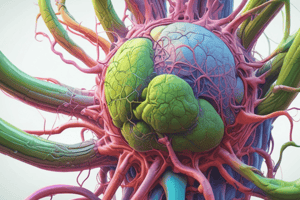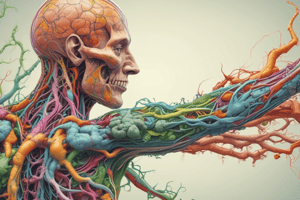Podcast
Questions and Answers
Which component of the lymphatic system is primarily responsible for filtering lymph?
Which component of the lymphatic system is primarily responsible for filtering lymph?
- Lymph nodes (correct)
- Spleen
- Thymus
- Tonsils
What is the primary function of lymphocytes within the immune response?
What is the primary function of lymphocytes within the immune response?
- Filter waste products from lymph
- Transport nutrients from the bloodstream
- Regulate fluid levels in the body
- Produce antibodies and attack infected cells (correct)
Which condition involves swelling due to the accumulation of lymph fluid?
Which condition involves swelling due to the accumulation of lymph fluid?
- Filariasis
- Lymphadenitis
- Lymphangitis
- Lymphedema (correct)
What role do memory cells play in the immune response?
What role do memory cells play in the immune response?
What is the primary role of lymphatic vessels?
What is the primary role of lymphatic vessels?
Which of the following is a characteristic of lymphoma?
Which of the following is a characteristic of lymphoma?
Where are lymph nodes primarily distributed in the human body?
Where are lymph nodes primarily distributed in the human body?
What is the main cause of filariasis?
What is the main cause of filariasis?
What describes the primary structure of a protein?
What describes the primary structure of a protein?
Which of the following accurately describes catabolism?
Which of the following accurately describes catabolism?
How do allosteric regulators primarily influence enzyme activity?
How do allosteric regulators primarily influence enzyme activity?
Which energy carrier is primarily involved in electron transport during cellular respiration?
Which energy carrier is primarily involved in electron transport during cellular respiration?
What technique is primarily used to determine the 3D structure of proteins?
What technique is primarily used to determine the 3D structure of proteins?
What does the Km value in enzyme kinetics represent?
What does the Km value in enzyme kinetics represent?
How does temperature affect enzyme activity?
How does temperature affect enzyme activity?
Which technology is used for gene editing at the molecular level?
Which technology is used for gene editing at the molecular level?
What is a key characteristic of autocrine signaling?
What is a key characteristic of autocrine signaling?
What is the primary function of transcription in molecular genetics?
What is the primary function of transcription in molecular genetics?
Which type of receptor is a G-protein coupled receptor categorized as?
Which type of receptor is a G-protein coupled receptor categorized as?
Which process follows the synthesis of RNA and involves the creation of proteins?
Which process follows the synthesis of RNA and involves the creation of proteins?
What is the primary consequence of mutations in DNA?
What is the primary consequence of mutations in DNA?
Flashcards are hidden until you start studying
Study Notes
Structure and Function
- Components: Composed of lymph, lymphatic vessels, lymph nodes, spleen, thymus, and tonsils.
- Lymph: Clear fluid containing white blood cells, proteins, and waste products.
- Lymphatic Vessels: Network of vessels transporting lymph towards the heart; similar to veins but with thinner walls and valves.
- Functions:
- Returns excess interstitial fluid to the bloodstream.
- Transports dietary lipids from the gastrointestinal tract.
- Provides a site for immune surveillance and response.
Immune Response
- Role in Immunity: Facilitates the transport of immune cells (e.g., lymphocytes) and antibodies throughout the body.
- Lymphocytes: B-cells (produce antibodies) and T-cells (attack infected or cancerous cells).
- Activation: Antigens are presented to lymphocytes in lymph nodes, triggering a specific immune response.
- Secondary Response: Memory cells produced during the initial exposure allow for quicker and stronger responses upon re-exposure to the same antigen.
Lymphatic Disorders
- Lymphedema: Swelling due to lymph fluid accumulation, often after lymph node removal or damage.
- Lymphoma: Cancer of the lymphatic system, characterized by the proliferation of lymphocytes.
- Infections: Such as lymphangitis (inflammation of lymph vessels) and lymphadenitis (inflammation of lymph nodes).
- Filariasis: Caused by parasitic worms blocking lymphatic vessels, leading to severe swelling.
Lymph Nodes
- Structure: Small, bean-shaped organs clustered along lymphatic vessels; contain lymphocytes and macrophages.
- Function:
- Filter lymph to remove pathogens and debris.
- Act as sites for lymphocyte activation and proliferation.
- Distribution: Found throughout the body, particularly in the neck, armpits, and groin.
Fluid Balance
- Role in Homeostasis: Maintains fluid levels in the body by collecting and returning excess fluid to the bloodstream.
- Filtration: Lymphatic system collects excess interstitial fluid that is not reabsorbed by blood capillaries.
- Edema Prevention: Prevents edema (swelling) by ensuring fluid is properly drained from tissues.
- Hydration: Contributes to overall hydration and electrolyte balance in the body.
Structure and Function
- Composed of various components: lymph, lymphatic vessels, lymph nodes, spleen, thymus, and tonsils.
- Lymph is a clear fluid that contains white blood cells, proteins, and waste products, playing a crucial role in the immune system.
- Lymphatic vessels form a network that transports lymph towards the heart, featuring thinner walls and valves compared to veins.
- Functions include returning excess interstitial fluid to the bloodstream, transporting dietary lipids from the gastrointestinal tract, and providing a site for immune surveillance and response.
Immune Response
- The lymphatic system facilitates the transport of immune cells, especially lymphocytes and antibodies, throughout the body.
- Lymphocytes consist of B-cells, which produce antibodies, and T-cells, which attack infected or cancerous cells.
- Activation of lymphocytes occurs when antigens are presented in lymph nodes, triggering a specific immune response.
- Memory cells generated during the initial exposure allow for quicker and stronger secondary immune responses upon re-exposure to the same antigen.
Lymphatic Disorders
- Lymphedema is characterized by swelling due to lymph fluid accumulation, commonly resulting from lymph node removal or damage.
- Lymphoma is a type of cancer affecting the lymphatic system, marked by the uncontrolled proliferation of lymphocytes.
- Infections can occur, leading to lymphangitis, which is inflammation of lymph vessels, and lymphadenitis, inflammation of lymph nodes.
- Filariasis is caused by parasitic worms blocking lymphatic vessels, resulting in significant swelling.
Lymph Nodes
- Lymph nodes are small, bean-shaped organs found clustered along lymphatic vessels and comprise lymphocytes and macrophages.
- Their primary functions include filtering lymph to remove pathogens and debris, as well as acting as activation and proliferation sites for lymphocytes.
- Distributed widely throughout the body, lymph nodes are particularly concentrated in regions such as the neck, armpits, and groin.
Fluid Balance
- The lymphatic system plays a key role in homeostasis by maintaining fluid levels in the body, collecting and returning excess fluid to the bloodstream.
- It filters excess interstitial fluid that is not reabsorbed by blood capillaries, preventing edema.
- By ensuring proper drainage from tissues, the lymphatic system helps prevent swelling (edema).
- In addition, it contributes to overall hydration and maintains electrolyte balance in the body.
Enzyme Kinetics
- Study of enzyme-catalyzed reaction rates, crucial for understanding metabolic processes.
- Reaction rate is defined as the speed of substrate conversion to product.
- Michaelis-Menten kinetics describes the dynamics of enzyme reactions, represented by the equation ( V = \frac{V_{max} [S]}{K_m + [S]} ).
- Vmax signifies the peak reaction velocity when substrate concentration is at saturation.
- Km, or Michaelis constant, indicates the substrate concentration at which the reaction velocity reaches half of Vmax, reflecting enzyme affinity.
- Enzyme kinetics are influenced by multiple factors:
- Temperature initially increases reaction rates but can lead to denaturation at extremes.
- Each enzyme has an optimal pH range for maximum activity.
- Inhibitors play a role, categorized as competitive (competing with substrate for active sites) or non-competitive (binding at alternative sites).
Molecular Genetics
- Focuses on the structure and function of genes at the molecular level.
- DNA is structured as a double helix and consists of four nucleotides: adenine (A), thymine (T), cytosine (C), and guanine (G).
- Gene expression involves two main processes:
- Transcription is the formation of RNA from a DNA template.
- Translation converts mRNA into protein.
- Mutations are alterations in the DNA sequence that can lead to changes in protein performance.
- Key techniques in molecular genetics include:
- PCR (Polymerase Chain Reaction) allows for the amplification of specific DNA segments.
- CRISPR is a modern gene editing technology used to modify genetic sequences.
Cell Signaling
- Cell signaling is essential for cellular communication, influencing various biological processes.
- Signaling pathways consist of a cascade of molecular events initiated by external signals.
- Types of signaling can be categorized as:
- Autocrine signaling where cells respond to signals they produce.
- Paracrine signaling involves nearby cells exchanging signals.
- Endocrine signaling utilizes hormones that circulate in the bloodstream to target distant cells.
- Receptors are critical for signaling, available as membrane-bound (such as G-protein coupled receptors) or intracellular (e.g., steroid hormone receptors).
- Second messengers like cAMP and calcium ions (Ca²⁺) play vital roles in propagating signals within cells.
Metabolic Pathways
- Metabolic pathways consist of sequences of chemical reactions that convert substrates into products, fundamental for energy management in cells.
- Catabolism refers to the biochemical process of breaking down molecules to release energy, with examples including glycolysis and the citric acid cycle.
- Anabolism, in contrast, involves synthesizing complex molecules from simpler ones and requires energy, exemplified by gluconeogenesis.
- Energy carriers such as ATP, NADH, and FADH₂ are crucial for transferring energy within cellular processes.
- Regulation of metabolic pathways primarily occurs through enzymes, which can be influenced by feedback inhibition and allosteric modulation.
Protein Structure
- Protein architecture is organized into four levels of structure:
- Primary structure consists of the linear arrangement of amino acids.
- Secondary structure includes localized folding patterns, notably alpha helices and beta sheets.
- Tertiary structure represents the overall three-dimensional configuration of a single polypeptide chain.
- Quaternary structure describes the complex formed by multiple polypeptide chains.
- The specific structure of a protein is pivotal in determining its function; misfolding can lead to diseases, including neurodegenerative conditions like Alzheimer’s.
- Analytical techniques such as X-ray crystallography are used to elucidate protein structures, while NMR spectroscopy provides insights into proteins in their natural solutions.
Studying That Suits You
Use AI to generate personalized quizzes and flashcards to suit your learning preferences.




